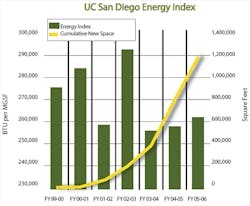5 Success Stories in Energy Management:
University of California, San Diego
Because nearly 60 percent of University of California, San Diego’s 11 million square feet of buildings (650 facilities) functions as laboratories and research facilities, the campus’ energy consumption consistently measures higher than typical university benchmarks. These spaces have special heating, cooling, and ventilation needs, requiring 5- to 10-times more energy per square foot than a typical building. Keeping this in mind, along with escalating electricity costs and California’s recent history of blackouts and brownouts, it’s easy to see why interest in energy efficiency has been a popular idea.
Additionally, the university’s researchers have been long-time proponents of environmental friendliness, so it’s only fitting that facility operations follow suit. “With UC San Diego faculty leading international efforts to reduce greenhouse-gas emissions and stop global warming, it has become even more important for the campus to ensure that its operations are sensitive to the global environment,” says John Dilliott, manager, energy and utilities, UC San Diego, La Jolla, CA. “Implementing a robust, all-inclusive energy-management program is just one of many ways that UC San Diego is accomplishing this.”
The results of the program have been just as big as the projects it has undertaken. Since the 1990s, the university has invested approximately $58 million in energy-management-related projects. Even more jaw-dropping than the payout is the payback: These projects, strategies, and equipment are yielding a whopping $11 million in annual energy savings.
With support from the highest levels of campus leadership, the team proceeded to implement only the big behind-the-scenes projects that would offer the best returns either campus-wide or in individual facilities. The impact was immediate, and not only was efficiency up and utility costs down, but another benefit was revealed: “The most important long-term result of having a campus energy-management program is improved reliability and performance of the central plant and HVAC and lighting systems,” Dilliott says.
When an engineering consultant reviewed and analyzed the university’s facilities, it was determined that those energy-intensive labs could consume less. The solution was an HVAC retrofit. Two of the campus’ largest labs were selected for the project. The constant-volume air supply and exhaust systems in both Pacific Hall and the Stein Clinical Research Facility were outfitted with variable frequency drives (VFDs) at a combined cost of $655,000. The project was completed in the spring of 2005; with a savings of $314,000 in utility costs expected annually, the university estimates that, in just over 2 years, the project will have paid for itself in energy savings.
In April 2001, UC San Diego installed a 26-MW gas turbine cogeneration plant on campus. In 2004, the size of the system was expanded to a 29-MW cogeneration plant with the addition of an efficient 3-MW steam turbine. This central energy source provides efficient heating and cooling to all major existing buildings on campus. “This system currently produces about 85 percent of all campus electricity while also using the waste heat to provide heating and cooling campus-wide at an efficiency improvement of approximately 30 to 40 percent when compared to grid-imported electricity and steam production in a conventional boiler,” Dilliott says. The replacement of an old steam turbine-powered chiller with the new steam turbine electrical generator will reduce UC San Diego’s reliance on utility-supplied electricity by more than 30 million kilowatt-hours per year, saving the university about $1.3 million annually.
One of the most important tools used by the team at UC San Diego is its energy-management system (EMS). In the mid-1990s, the campus upgraded to a centralized direct digital system. With centralized control of mechanical systems, monitoring and advance programming is easier. According to UC San Diego, the EMS facilitates
- Reduction in peak-time energy demand.
- Management of heating and cooling setpoints.
- Maximum conservation through night and weekend programming.
- Long-term trending and comparative analysis.
If there’s anything to be learned from the example the energy and facilities teams at UC San Diego set, it’s that even a relatively young campus can reap big benefits from implementing ambitious and aggressive energy-conservation measures.

